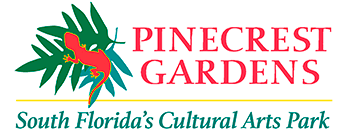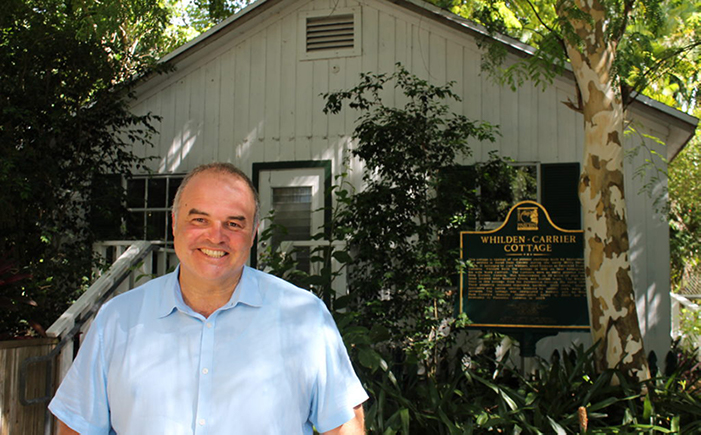

artist-in-residence
Xavier Cortada serves as the artist-in-residence at Pinecrest Gardens, where his studio and foundation are based. In this role, Cortada has worked to create a unique and impactful experience for anyone who comes to explore the Gardens.
As soon as visitors pull into the Pinecrest Gardens parking lot they are met with Cortada’s artwork – specifically his Pinecrest Mangrove Forest, a 200-ft long mangrove mural alongside the county’s first urban mangrove forest. Proceeding to the entrance of the Gardens, visitors find the Hibiscus Gallery, a space exhibiting Cortada’s signed, numbered, limited edition prints which are available for purchase onsite and online. After viewing the current exhibitions, visitors are invited to engage with Cortada’s artwork across the Gardens:
- participate in some of Cortada’s socially engaged art projects along the Eco-art Colonnade
- recreate the ritual that Cortada performed at the North & South Poles, the Longitudinal Installation
- take 5 deep breaths and recite the Diatom Oath at Diatom Court
Pinecrest Gardens
Pinecrest Gardens, South Florida’s Cultural Arts Park, features over 1,000 varieties of rare and exotic tropical plants and palm trees in a native tropical hardwood and cypress setting. The dramatic landscape enhanced with natural streams, caves and fissures provides a dramatic stage for its historically designated structures and buildings.
“Pinecrest Gardens celebrates, cultivates and conserves South Florida’s rich botanical heritage. We enrich our community through historic preservation; demonstrate a commitment to nature through education, community service, sustainability; and provide an entertainment destination that fosters artistic excellence, diversity and spirit of community.”
pinecrest gardens launches cortada's eco-art colonnade
On December 5th, 2021, the Village of Pinecrest dedicated Xavier Cortada’s Eco-art Colonnade, an interactive 200-foot long eco-art exhibition at Pinecrest Gardens. The Eco-art Colonnade showcases a collection of Cortada’s most important projects so visitors can learn about critical environmental issues impacting South Florida, participate in a range of ongoing eco-art initiatives, and ultimately discover how they can help to protect people and the planet.
Among the nine featured participatory art projects are the “Underwater HOA” (the internationally renowned effort convening neighbors to plan for sea level rise), “Seahorse Society” (where participants pledge to protect Biscayne Bay and its seagrasses), and “Native Flags” (the urban reforestation campaign that Cortada launched at the North Pole in 2008). Each of the projects along the Colonnade provides an overview of the problem that it attempts to address, the history of the project, and a way for visitors to participate either on-site or at home.
“At a time when our environmental future looks so bleak, it is heartening to share ways in which we can each take individual action to make a difference,” said Cortada. “These participatory eco-art projects aim to inspire and engage our community members to become protagonists in the fight against global climate change and rising seas.”
Since his first participatory eco-art project in 2006, the “Reclamation Project,” Cortada has inspired tens of thousands of people to become curious about the natural world that captivated him as a child. Other featured projects in the Eco-art Colonnade include “Florida is… Nature,” “Endangered World,” “Plan(T),” and “Letters to the Future,” all of which attempt to raise awareness about and motivate action toward the threats of climate change, environmental degradation, and biodiversity loss.
“We are so honored to house this incredible artist in our gardens and cultural arts park,” said Alana Perez, Director of Pinecrest Gardens. “This innovative, interactive living exhibition is a true gift to our community and to those in the future who will benefit from the eco-actions it will generate.”
The Eco-art Colonnade serves as a platform for community members, families, and children to have conversations about and commit to protecting Florida’s natural beauty.
Cortada asks visitors to participate in his nine eco-art projects by having them adopt endangered animals, plant native wildflower gardens, pledge eco-actions, mark their homes’ elevation above sea-level, plant salt-tolerant native trees, and write short letters to someone in the future. According to Cortada, “Working and learning together, we can all problem-solve to make ours a more just, loving and beautiful world.”
“What a delight it is to learn of the EcoArt Colonnade in Miami’s Pinecrest Gardens Park honoring the outstanding work of Xavier Cortada, one of the first artists in South Florida to engage ecological art as a practice,” said art historian Mary Jo Aagerstoun. “I believe Cortada’s EcoArt continuum will soon outgrow the 200 feet that the upcoming Colonnade will embrace. And so it should.”
The Eco-art Colonnade joins Cortada’s other public art gems in the garden, including Pinecrest Mangrove Forest (Miami’s first urban mangrove garden), Diatom Court (commemorating FCE LTER scientists who study the Everglades) and the Longitudinal Installation (a replica of the work the artist installed at the South Pole in 2007 to raise awareness of global climate change).
Unveiled in conjunction with the Eco-art Colonnade was Pinecrest Gardens’ Digital Corridor, a centralized hub designed to help visitors experience Cortada’s artwork across the gardens, feature artwork that Cortada has created throughout the community, and provide an online gallery of Cortada’s limited-edition prints available in the garden’s Hibiscus Gallery.
WHAT IS ECO-ART?
Ecological art is an art genre and artistic practice that seeks to preserve, remediate and/or vitalize the life forms, resources and ecology of Earth, by applying the principles of ecosystems to living species and their habitats throughout the lithosphere, atmosphere, biosphere, and hydrosphere, including wilderness, rural, suburban and urban locations. It is a distinct genre from Environmental art in that it involves functional ecological systems-restoration, as well as socially engaged, activist, community-based interventions. Ecological art also addresses politics, culture, economics, ethics and aesthetics as they impact the conditions of ecosystems. Ecological art practitioners include artists, scientists, philosophers and activists who often collaborate on restoration, remediation and public awareness projects.
ART HISTORIAN’S PERSPECTIVE
What a delight it is to learn of the EcoArt Colonnade in Miami’s Pinecrest Gardens Park honoring the outstanding work of Xavier Cortada! Cortada is one of the first artists in South Florida to engage ecological art as a practice. Over the past 15 years, his work has been seen on the pillars under I-95, and in various exhibition venues from the most humble to the most exalted. But, for me, the most important aspect of his work is not in the objects and murals which have been widely praised, it is in his ecological art process. I have described Cortada as a “choreographer” of everyday people, who learn how to dance into ecological stewardship as they perform ecologically positive actions at his direction. All the projects to be featured in the Colonnade are moments in time across a large, ongoing project that uses time as its medium: time it takes for endangered Florida plants to proliferate across many landscapes; time it takes for would be eco-stewards to absorb how to skillfully perform the dance of preservation Cortada directs; and time for multiple simultaneous conversations to happen—people to people, people to plants, plants to people, plants to animals, animals to plants, and natural systems with natural systems, all aiming for one outcome, the survival and flourishing of humans and the more-than-human animals and vegetation that keep our earthly systems in balance. I believe Cortada’s EcoArt continuum will soon outgrow the 200 feet that the upcoming Colonnade will embrace. And so it should. We need Cortada to keep expanding his practice, and many more artists following his lead in thinking creatively about how to “stay with the trouble,” in damaged landscapes, as the scientist and philosopher Donna Haraway has encouraged us to do as dystopia become ever more real. —Mary Jo Aagerstoun, Ph. D., art historian and founder EcoArt South Florida (2007-2015) and the international FB platform Artists for Climate Action (2015 to the present).